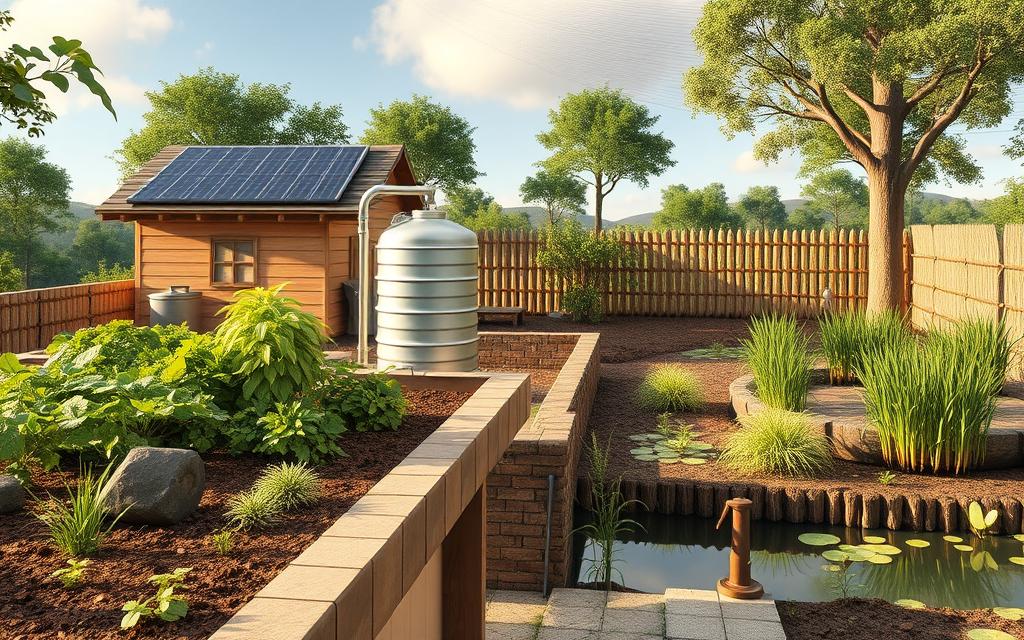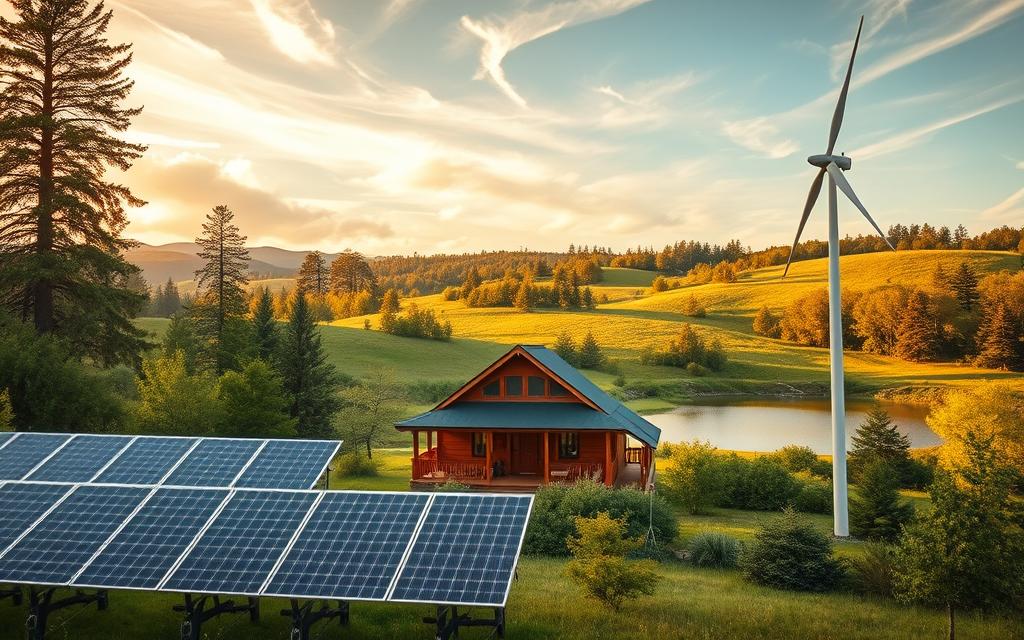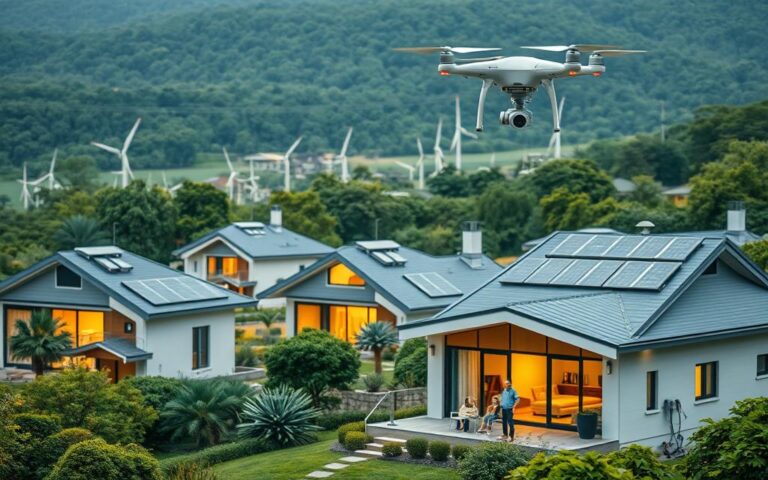Did you know about 3 million U.S. households live off the grid? This number is growing as more people want energy independence and sustainable living. Off-grid systems use solar and wind power. They let homeowners avoid traditional utilities and reduce their carbon footprint.
With climate change and rising energy costs, renewable energy homes are more appealing than ever. These systems don’t just make electricity. They also manage water and waste. This makes living sustainable and improves life quality while protecting the environment.
Understanding Off-Grid Systems
Off-grid living means being completely self-sufficient in energy, without relying on public utilities. It often involves using renewable tech like solar panels, wind turbines, and storage systems. This lifestyle is becoming more popular, especially for those who want to live eco-friendly and aim for net zero energy homes.
What Does Off-Grid Mean?
“Off-grid” means not using traditional power sources. People who live off-grid make their own electricity using green methods. This not only meets their energy needs but also helps create a more sustainable future.
Benefits of Energy Independence
Choosing off-grid systems gives you more control over your energy use. The advantages are many:
- Lower utility bills: You can save a lot on monthly costs.
- Protection against fluctuating energy prices: With energy costs rising, having your own source keeps costs stable.
- Resilience during power outages: Your home stays functional even when the grid goes down.
- Environmental contribution: Using renewable energy helps reduce carbon footprints, supporting eco-friendly living.
Key Components of Off-Grid Home Systems
Thinking about switching to renewable energy homes means learning about key technologies. These parts help homeowners use nature’s power well. They make homes energy-efficient and sustainable.
Solar Power Solutions
Solar power is a main energy source for many off-grid homes. Solar panels turn sunlight into electricity, making it a dependable choice. Homeowners can pick from different solar panels, like monocrystalline and polycrystalline, each with its own benefits.
Using these systems cuts down on non-renewable energy use. It also helps lead a sustainable life.
Wind Energy Systems
Wind energy systems work well with solar solutions, especially in windy areas. They use turbines to turn wind into electricity. Choosing the right turbine size and type depends on local wind and energy needs.
By mixing solar and wind, homeowners get a balanced energy solution. This maximizes energy production in different weather.
Energy Storage Options
Energy storage is crucial for off-grid systems, ensuring constant power. Technologies like rechargeable batteries store extra energy for later use. Upgrading to advanced batteries like lithium-ion improves system efficiency and life.
Designing Your Off-Grid Home
Building an off-grid home needs careful planning and design. It’s important to pick the right site and materials. This ensures your home is both green and comfortable.
Site Selection and Planning
Finding the perfect spot is key for an energy-saving home. Look for places with lots of sunlight and good drainage. Being close to nature is also a plus.
Using passive solar design lets your home use the sun’s light and heat. This cuts down on the need for outside energy. Think about your local climate to choose the best insulation and exterior materials.
Essential Building Materials
The materials you choose are crucial for a green home. Go for options like reclaimed wood, bamboo, and safe insulation. These choices help the planet and make your home healthier.
Using natural materials helps keep your home’s temperature steady. This makes your home more comfortable and energy-efficient.
Sustainability Considerations
Make sure your off-grid home is sustainable. Use green building methods like collecting rainwater and managing waste well. Choose materials that are good for the environment.
Think about how materials affect the planet over time. A home that fits with nature is better for you and the planet. It also lasts longer and saves energy.
Energy Consumption and Management
Efficient energy use is key for off-grid homes. Knowing your energy needs helps keep your home powered well. It also helps in making your home more energy-efficient.
Assessing Your Energy Needs
First, check how much energy each appliance in your home uses. Look at the wattage and how often you use them. This includes everything from heating and cooling to electronics.
This info helps you plan a home that uses as much energy as it makes. Using energy-efficient appliances can cut down your use even more. This makes living more sustainable.
Monitoring Energy Usage
Keeping track of your energy use is important. Smart meters and tools give you real-time data. This lets you see how you use energy and make changes.
With this data, you can save more energy. It also helps you reach your goal of a carbon-neutral home. You get to control how much energy you use.
| Appliance | Wattage | Daily Usage (hours) | Daily Energy Consumption (kWh) |
|---|---|---|---|
| Refrigerator | 200 | 24 | 4.8 |
| LED Lighting | 10 | 6 | 0.06 |
| Television | 100 | 4 | 0.4 |
| Washing Machine | 500 | 1 | 0.5 |
| Computer | 300 | 8 | 2.4 |
Choosing Renewable Energy Sources
Switching to renewable energy is a big step towards living sustainably and making homes energy-independent. Each option has its own benefits and challenges. Homeowners need to weigh these to get the most out of their choices.
Comparing Solar and Wind Energy
Solar energy is becoming more popular because it’s easy to get and costs less to install. Many people can use solar panels to make their own energy. Wind energy is also a good choice, especially in areas with steady winds.
Choosing between solar and wind depends on several things. These include where you live, how much energy you use, and what you prefer in terms of upkeep.
The Role of Biomass
Biomass is another key part of off-grid energy plans. It uses organic stuff like wood pellets or farm waste to make energy. This makes homes more energy-independent and supports sustainable living.
Using biomass also helps reduce waste and uses resources wisely. It’s a smart way to make energy and live sustainably.
Water Supply and Management
Managing water supply is key for off-grid homes. It helps in using water wisely. Rainwater harvesting and filtration are important for saving water.
Rainwater Harvesting Systems
Rainwater harvesting systems collect and store rainwater. This cuts down on the need for city water. Homeowners can use this water for many things, like watering plants or flushing toilets.
Water Filtration and Purification
It’s important to make rainwater safe to drink. Sand filters or UV systems can clean the water. This makes sure families have clean water to use.

Waste Management Solutions
Effective waste management is key for off-grid living. It supports green practices. Composting toilets and greywater recycling are two main methods. They help manage waste and promote sustainable living.
Composting Toilets
Composting toilets are an eco-friendly choice instead of regular sewage systems. They turn human waste into compost, saving water. This method cuts down on environmental harm and helps gardens grow.
Greywater Recycling Systems
Greywater systems use water from sinks, showers, and washing machines for gardens. It’s a smart way to save water. Using greywater systems fits well with sustainable living, reducing waste and using water wisely.
| Waste Management Solution | Description | Environmental Benefits |
|---|---|---|
| Composting Toilets | Toilets that convert human waste into compost without using water. | Reduces water usage; transforms waste into useful compost. |
| Greywater Recycling Systems | Systems that reuse water from household activities for irrigation. | Conserves water; promotes sustainable use of resources. |
Cost Analysis of Off-Grid Living
Looking into the money side of off-grid living is key for those thinking about it. A detailed cost analysis shows the upfront costs and the long-term savings of being energy independent. Knowing the costs of off-grid living helps make a smart choice.
Initial Investment Breakdown
The first costs of off-grid living can change a lot, depending on what you choose. You’ll need solar panels, wind turbines, batteries, and more. These can cost between $15,000 and $50,000, based on the system size and where you live.
Comparing these costs to getting utility lines extended often shows the savings of going off-grid.
Long-Term Savings Over Time
Going off-grid means big savings over the years. You won’t have to pay for utilities every month, saving a lot each year. As utility prices go up, using renewable energy helps keep your costs stable.
This makes off-grid living a great choice for many. The more time goes by, the more you’ll save, making a cost analysis very important.
Legal and Regulatory Considerations
Before starting your off-grid living journey, it’s key to know the legal aspects. With more people turning to renewable energy, it’s important to understand local zoning laws. These laws can greatly affect your project. Knowing the rules in your area helps you move forward smoothly.
Understanding Local Zoning Laws
Local zoning laws affect many parts of your off-grid home. They cover the size and type of energy systems you can use. The rules change based on the type of zoning in your area.
It’s vital to research local laws. This helps you know what you can build and use on your land. It’s a big step towards living off the grid.
Permitting for Off-Grid Systems
Understanding zoning laws is just the start. You also need to get permits for your off-grid systems. Solar panels and wind turbines need special permits. Not getting these can cause fines or delays.
It’s smart to talk to local authorities early on. They can guide you on following energy and water laws. This protects your investment and makes setting up your off-grid home easier.



